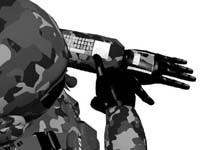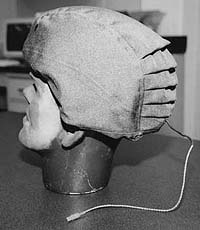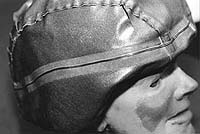|
Future warrior systems include heads-up displays, global positioning systems, combat identification sensors, chemical detectors, electronically controlled weapons and physiological status monitors connected to the soldier’s computer for instant information access. A manufacturing technology program at the U.S. Army Soldier Systems Center (Natick) is exploring ways to integrate electric wires and fiber optics into textile materials that will enable future soldiers to use sophisticated battlefield capabilities without the weight and bulk. An electric wire integrated into a helmet cover would be connected to another part of the uniform. Several production-based manufacturing processes are being investigated to develop the techniques needed to support mass production capabilities of electro-optic textiles, says James G. Fairneny, an electrical engineer and project manager for Manufacturing Processes for Integration of Electro-Optic Conductors and Devices Into Textiles at Natick. “The goal is to provide the war fighter with executable functions that require the fewest possible actions on his or her part to initiate a response to a situational combat need by means of intelligent textiles.” Cooperation between Natick Soldier Center’s Individual Protection Directorate and the Objective Force Warrior Tech- nology Program Office, Communications and Electronics Command at Fort Monmouth, N.J., and several other military, academia and industry groups are involved with various textile-based projects to make it possible. A helmet cover turned inside out shows how an electrical wire can be embedded in fabric through stitchless seam technology. Invisible antenna Similarly, a proto-type to replace the antenna for the low-frequency band SINGARS radio was built into a fabric vest by BAE Systems Aerospace Inc. Manufacturing technology examined the fabrication and feasibility of building transmission lines and radiation elements for the wearable textile-based antenna. Clean connection Exponents at Natick and Thor Electronics Inc., in Salinas, Calif., are working to upgrade the network cables and manufacture a flat, pinless connector with recessed contacts. This connector uses flat pieces of metal that easily can be designed in 11, 21 and 31 pinless contacts for various cable configurations. The setup dramatically reduces the cost of existing custom connectors now used by Land Warrior. The prototype ultra-low-profile rectangular connector system has a plug and receptacle in controlled-force breakaway and quick disconnect configurations and can be used in a fabric-based bus or conventional cable. Leaner and lighter yet rugged, the connector eliminates the expensive pin-and-socket assembly process. It meets military requirements for environmental and electrical compatibility, and parts are domestically available and made in high volume. A new connector should reduce the cost of existing custom connectors now used by the Land Warrior system. Additionally, the American Competitive Institute (a consortium of industry and academia) in Philadelphia will investigate alternative components for flat-body conformal connectors and cables. Several commercial products are being considered with concept designs that modify the manufacturing process to lower product costs. Electrical tests and environmental evaluations are being conducted on modified and all-new products. Blended fibers Photonics Laboratories, Inc. in Philadelphia and the Philadelphia School of Textiles have a contract to develop manufacturing processes for integrating optical fibers and traditional wires into woven and knitted textiles. With these technologies, conductors and optical-electronic systems could be woven into soldier’s uniforms during large-scale manufacturing. “They’re looking at the physical interaction of wires or optics as it goes through machinery,” Fairneny says. Textile structures are physically and mechanically different from fiber optics or wires. “Fiber optics bent too much will break, while metal wires don’t bend back and can get fatigued.” At the Philadelphia School of Textiles, researchers are invest-igating the mechanical motion of textile fibers to see if it would be possible to make modifications to incorporate fiber optics and conductive wires. Mechanical parts that produce sharp bending were identified for potential change as well as looking at a variety of fiber optics most able to handle bending. Entrapped The technique entraps fiber optics and conductors either on top of or along the seam of the fabric. Clemson Apparel Research at Clemson University in Pendleton, S.C., is investigating combinations of wires that form the electrical characteristics of commercial cables, available connectors and garment-to-garment and undergarment-to-garment mechanisms. “One difficulty will be trying to connect the top to the bottom for a complete uniform network,” Fairneny says. Clemson is considering the specific network needed for Land Warrior laser sensors on the helmet cover and a general network for the Battle Dress Uniform (BDU) top. The first samples of fabric containing electrical wires and a helmet cover network have been provided. Fiber keyboard A keyboard built into a uniform sleeve is a way to remove bulky control units from a soldier’s load. “The keyboard would be pressure-sensitive, not touch-sensitive, for use on the battlefield,” Fairneny says. “Land Warrior’s soldier control unit is a box that sits on the chest. It would be better to integrate that into the clothing for reduced weight.” One goal is to produce a keypad on the sleeve that can function as the soldier control unit with specific military functions. A textile data bus and necessary connectivity to transport the signal from the keyboard to the control electronics is another goal. Fairneny says an initial prototype is expected to provide three or four keys needed for a few simple commands to prove the concept. Further development should lead to a BDU housing to hold the electronics and a fabric-based display. |
|
| Above story first appeared in MADE TO MEASURE Magazine, Fall & Winter 2002 issue. All rights reserved. Photos appear by special permission. | |
| Halper Publishing Company 633 Skokie Blvd, #490 Northbrook, IL 60062 (847) 780-2900 Fax (224) 406-8850 [email protected] |
|
Home Fall & Winter 2002 Electrified: U.S. Army Soldier Systems Center explores ways to manufacture wired clothing














